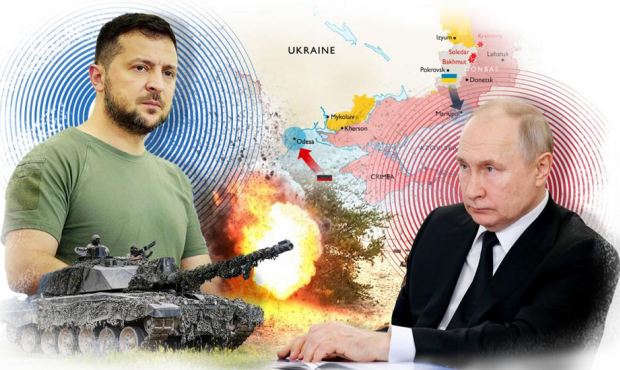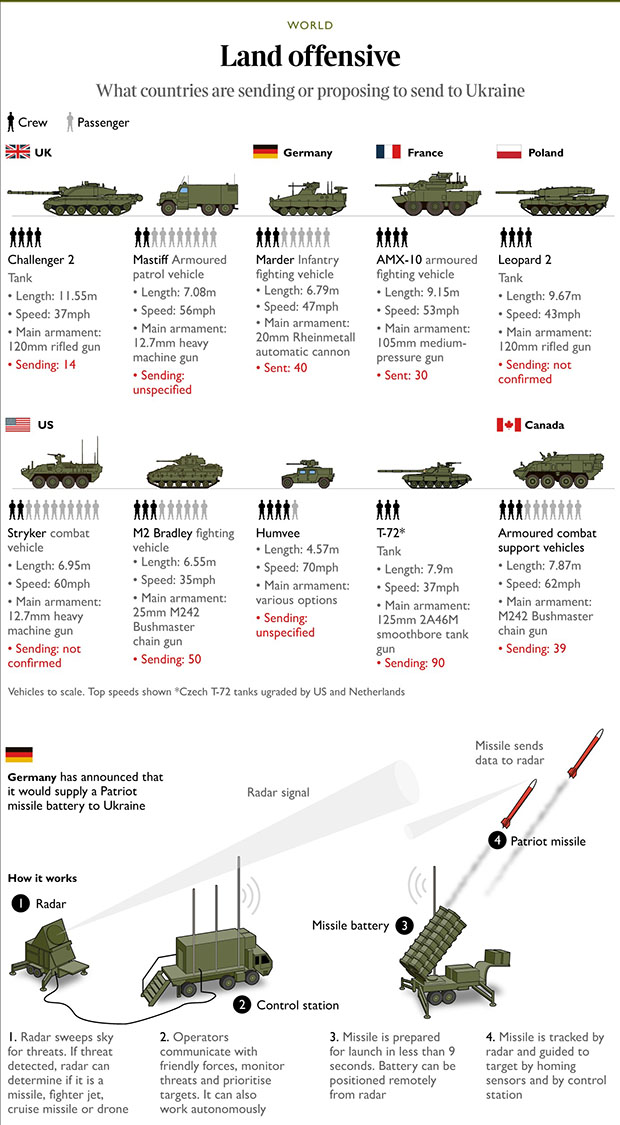Kyiv tries to rally West before ‘500,000 Russians’ go to front
Moscow has declared its first victory in months and is emboldened by high levels of Russian support for the war. In response, Europe could send tanks to Ukraine for the first time

President Putin could mobilise up to half a million extra troops for his war against Ukraine as he seeks to wrestle back the initiative with a multipronged spring offensive.
Western allies are being urged to “act now” and send hundreds of tanks and armoured vehicles to Ukraine after Putin appointed a new commander and laid plans to deploy 150,000 reservists who were conscripted in the autumn.
Russia claimed its first victory in months yesterday, as Ukrainian troops began withdrawing from the town of Soledar after a battle that cost thousands of lives. Its fall gives the Russians a greater chance of seizing nearby Bakhmut, which controls access to Kramatorsk and Slovyansk, the last big cities in Ukrainian hands in Donetsk.

Last night President Zelensky said: “The tough battle for Donetsk continues. The battle for Bakhmut and Soledar, for Kreminna, for other towns and villages in the east of our state continues.”
Western intelligence indicates that Putin could announce a fresh mobilisation soon, emboldened by polling suggesting that, despite many setbacks on the battlefield, Russian support for the war remains high. If a decision is taken within weeks, as many as 500,000 extra Russians could be trained and sent to the front by April, when Ukraine’s winter mud has dried sufficiently to allow a big offensive.
“There are serious preparations going on across Russia’s regional recruitment offices,” one western official said. “The Kremlin has done private polling. Ordinary Russians are anxious about the war, but they are also unwilling to tolerate defeat.”
Ukraine has as many soldiers in the battlefield as Russia, western officials believe, but General Valery Gerasimov, the new commander, will need to outnumber Ukrainian forces by three to one to capture more territory.
Western defence ministers will meet in Germany next week to agree new support that could mean tanks being sent to Ukraine for the first time. Britain is preparing to send 14 Challenger 2s in an attempt to encourage other allies — notably Germany and the US — to give theirs. Poland says it is willing to provide a similar number of Leopard 2s.
General Valery Zaluzhny, the Ukrainian chief of the general staff, has said that Kyiv needs 300 tanks and 600-700 armoured vehicles to recapture its territory and defeat Russia, a figure not considered unreasonable in some western capitals despite jitters in Washington and Berlin.
General Sir Richard Barrons, a former senior British commander in Iraq and Afghanistan, said 14 Challenger 2s were enough to take “this village or that village, it doesn’t do two villages”. He said tank training that usually lasted months would have to be condensed into weeks for Ukraine to be ready to launch a spring offensive.
“The Ukrainians feel they have to maintain momentum and a sense of success or the West will lose interest,” he said. “If they really could, they should wait until next year and build the mother of all offensive forces with 500 tanks they know how to use and then it’s game over. But they’re not in that position, or they feel they can wait. And they’re probably right.”
Segei Surovikin, nicknamed General Armageddon, was replaced by Gerasimov as Russia’s highest-ranking military officer this week in a power struggle that also involved Yevgeny Prigozhin, the petty criminal who escaped the brutalities of the Soviet penal system to head the Wagner Group. His mercenaries now make up a quarter of the Russian forces in Ukraine and may even have taken command of the battle for Bakhmut, western officials believe.
Prigozhin, 61, was rebuked by the Kremlin after trying to claim credit for advances in Soledar, where ex-convicts were allegedly threatened with execution if they turned away from the guns — tactics reminiscent of Stalin’s famous 1942 diktat “Not a step back!”
Professor Michael Clarke, the former director-general of the Royal United Services Institute, said the Kremlin was trying to reassert authority by appointing Gerasimov and ready Russian forces for an offensive in the spring.
“Putin is preparing for a more co-ordinated approach at the top of the Russian armed forces,” he said “The appointment of Gerasimov is a response to Prigozhin and [Ramzan] Kadyrov [the warlord leader of Chechnya] both overplaying their hand. The command chain is tightening up at the Kremlin end to defend itself against these wild warlords running around in Ukraine itself. Prigozhin has allowed Wagner fighters to go on camera and describe Putin, the Kremlin and the Russian armed forces as shit.”

Military experts believe that Russia will launch its multipronged attack in the spring to divert Ukrainian resources away from Donetsk and Luhansk.
Russian warships left Novorossiysk this week, prompting renewed fears of a landing from the Black Sea. Gerasimov could be tempted to send troops on another foray into northern Ukraine from Belarus. Neither offensive is likely to result in Russia gaining more territory, but by feinting attacks on different parts of the country, Russian generals may be hoping to drain Ukrainian resources from the main fighting.
“Putin intends to escalate the conflict and Gerasimov is the best figure for co-ordinating that,” a Ukrainian defence source said. “This is not some sort of Game of Thrones between Prigozhin, Surovikin and Gerasimov. The Russians are preparing for the final battle.”
Despite the Ukrainian fears, there is little to suggest that Gerasimov is a first-rate tactician. Slavishly loyal to Putin, it was he who planned the initial disastrous invasion of Ukraine.
George Grylls, Richard Spencer / The Times
